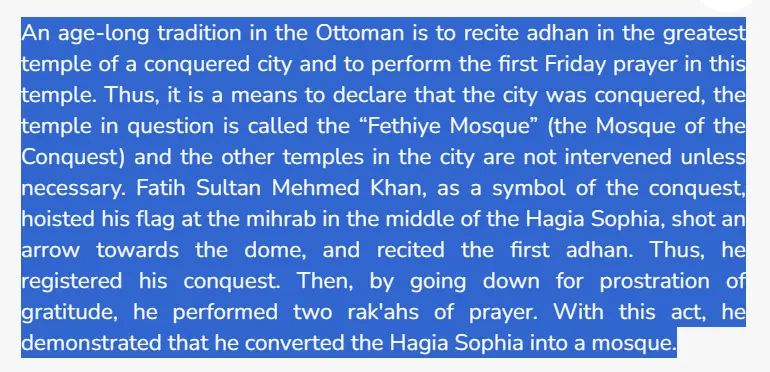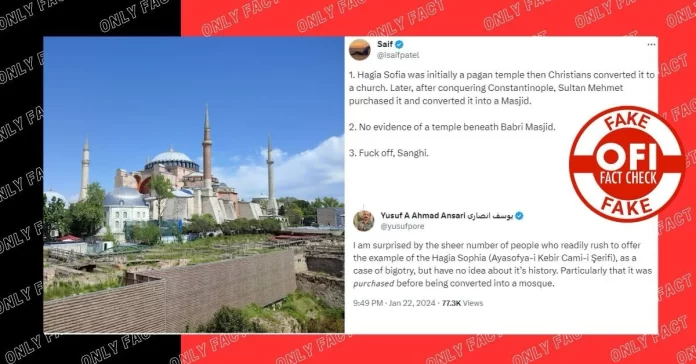On the 22nd of January, a momentous event unfolded in Ayodhya as the Pran Pratishta ceremony marked the consecration of the Vigraha of Ram Lalla within the newly erected Ram Mandir. This occasion, resonating with profound significance, sought to redress a historical injustice perpetrated nearly five centuries ago by the Mughal Emperor Babur. For devout Hindus worldwide, it stood as a jubilant and auspicious moment, a culmination of a fervent and longstanding aspiration. However, as the joyous echoes reverberated among the true adherents of Hinduism, a contrasting narrative emerged from the realms of communists and Islamists.
As Hindus reflected upon recent events in Ayodhya, their attention turned to a parallel situation in Turkey involving the historic Hagia Sophia. Three years prior, the Supreme Court of Turkey issued a decree for the conversion of the Hagia Sophia Museum into a Mosque. Notably, in the wake of this decision, Islamists found themselves in a precarious position, contending with criticism and resistance. In an attempt to rationalize the conversion, some proponents argued that Mehmed Khan had purportedly acquired Hagia Sophia through a legitimate transaction, transforming what was once a church into a mosque.
Islamists Saif tweeted, ‘Hagia Sofia was initially a pagan temple then Christians converted it to a church. Later, after conquering Constantinople, Sultan Mehmet purchased it and converted it into a Masjid.’
1. Hagia Sofia was initially a pagan temple then Christians converted it to a church. Later, after conquering Constantinople, Sultan Mehmet purchased it and converted it into a Masjid.
— Saif (@isaifpatel) January 22, 2024
2. No evidence of a temple beneath Babri Masjid.
3. Fuck off, Sanghi. pic.twitter.com/drtSYS4Qm7
Another Islamist Yusuf A Ahmad Ansari wrote while replying to Saif, ‘I am surprised by the sheer number of people who readily rush to offer the example of the Hagia Sophia (Ayasofya-i Kebir Cami-i Şerifi), as a case of bigotry, but have no idea about it’s history. Particularly that it was 𝘱𝘶𝘳𝘤𝘩𝘢𝘴𝘦𝘥 before being converted into a mosque.’
I am surprised by the sheer number of people who readily rush to offer the example of the Hagia Sophia (Ayasofya-i Kebir Cami-i Şerifi), as a case of bigotry, but have no idea about it’s history. Particularly that it was 𝘱𝘶𝘳𝘤𝘩𝘢𝘴𝘦𝘥 before being converted into a mosque.
— Yusuf A Ahmad Ansari یوسف انصاری (@yusufpore) January 22, 2024
In this article, we will ascertain the veracity of assertions put forth by radical Islamists who contend that Mehmed Khan purchased the Hagia Sophia.
Also Read: No, the person’s average Income in India is not Rs 22 per Day
Fact Check
Our investigation began by delving into the history of Hagia Sophia. We started with the official website of the Hagia Sophia Mosque, which it clearly says that Fatih Sultan Mehmed Khan, who was given the title of Roman Emperor, took control of all properties from the Byzantine dynasty. He initiated the mosque by performing the first prayer in Hagia Sophia and established the ‘Fatih Complex and the Hagia Sophia Al-Kabeer Foundation.’

The website also explains an old Ottoman tradition. After capturing a city, it was customary to recite the adhan in the main temple and hold the first Friday prayer. The mosque resulting from this conquest was called the “Fethiye Mosque” or the Mosque of the Conquest. Fatih Sultan Mehmed Khan, as a symbol of victory, raised his flag at the mihrab in the center of Hagia Sophia, shot an arrow towards the dome, and recited the first adhan. This act, like planting a flag, marked the official conquest. He then knelt down in gratitude, performing two rak’ahs of prayer to emphasize the transformation of Hagia Sophia into a mosque.

In our meticulous fact-checking pursuit, we referred to the insights offered in “The Fall of Constantinople 1453” by Sir James Cochran Stevenson Runciman. According to the author, the city faced rampant looting and pillaging during its fall. Runciman emphasizes a recurring theme he terms as “tradition,” citing a Muslim practice wherein conquering soldiers were granted three days of unrestrained plunder, encompassing activities such as looting, killing, enslavement, and rape. This unfortunate destiny extended to the churches of Constantinople, including Hagia Sophia, as recounted by Runciman, who affirms that Saint Sophia, or Hagia Sophia, was promptly converted into a mosque.
According to these historical accounts, Hagia Sophia explicitly calls itself the “mosque of conquest.” After conquering Istanbul, Sultan Mehmed Khan took control of all properties from the Byzantine dynasty, confirming this acquisition by dedicating the first prayer in Hagia Sophia as a mosque.
In our continued exploration, we looked into the landmark verdict of the Turkish Supreme Court in 2020. According to Reuters, the highest court deemed the conversion of the ancient structure into a museum, orchestrated by the founding statesman of modern Turkey, as illegitimate. Subsequently, President Tayyip Erdogan officially proclaimed Hagia Sophia in Istanbul as a mosque.
“With this court ruling, and with the measures we took in line with the decision, Hagia Sophia became a mosque again, after 86 years, in the way Fatih the conqueror of Istanbul had wanted it to be,” Erdogan said in a national address.
Originally erected as a cathedral during the Christian Byzantine Empire in the sixth century, Hagia Sophia transformed into a mosque following the Ottoman conquest of Constantinople in 1453. The subsequent conversion into a museum marked a significant reform initiated by the post-Ottoman authorities, spearheaded by the founder of the modern republic, Mustafa Kemal Ataturk.
To wrap up, Hagia Sophia wasn’t bought; it came under the ownership of Mehmed Khan after the capture of Constantinople in 1453. The name “Fethiye Mosque,” meaning the Mosque of the Conquest, perfectly reflects what Hagia Sophia stands for. The claims made by the Islamists are not backed by evidence and are simply not true.
| Claim | Hagia Sophia was purchased by Mehmed Khan |
| Claimed by | Islamists |
| Fact Check | Fake |
Also Read: The Wire’s False Narrative: Denying the Existence of Temple Beneath Babri Mosque









